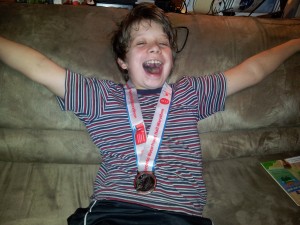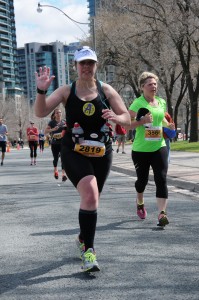The trouble with drawing up a training schedule is that I feel obligated to follow it. This is, under normal circumstances, not a bad thing. The schedule holds me accountable and keeps me on track. If I stick with the program, I can be reasonably confident that I will meet whatever goal I have set out to accomplish.
The trouble starts when something happens that forces me to deviate from the schedule. Changes in plans make me feel vaguely anxious, and if I don’t get to do a run that I’ve been mentally gearing myself up for, it’s a little disruptive to my psyche. But we all know that life is that thing that happens while we’re making other plans, and sometimes we just have to roll with whatever life throws at us.
Not that life has thrown me anything major in the last week. In fact, I knew going into the week that my training schedule would have be adjusted. I volunteered at the Toronto Women’s Half-Marathon on Sunday, and I didn’t want to go for a long run on top of that. I was on my feet for the whole morning, and in any case, I wanted to hang out with my family instead.
Plan B was to go for a long run on Monday afternoon instead. I really needed two hours to complete the distance, and due to a series of unforeseen issues that had to be taken care of right away, by the time I set out I only had an hour available to me. That turned out to be plenty: it was very hot on Monday afternoon, and because my body has not yet acclimatised to the warmer weather, there is no way I would have been able to pull off 18K. I did about 9K, and that just about killed me. Before I had done the first kilometre, I knew I was in trouble. During the run, there were a couple of unscheduled walking breaks, plus one lean-against-a-tree-and-cry break.
On Tuesday I had a rest day. I had planned to rest, but I wouldn’t have had a choice anyway. Monday’s run had the effect of completely draining me of energy. I was exhausted beyond belief, to the extent that I worried about whether Wednesday’s run would happen.
On Wednesday morning, I saw the kids off to school and then, with trepidation, I put on my running shoes. I was supposed to do a 5K tempo run, and I really didn’t know if I had it in me. I needn’t have worried: I had a fabulous run. I did 5K in just under 30 minutes, and I felt great.
Thursday was another rest day, but not an intentional one. I had some errands to run, and I met a friend for lunch, and time just ran away from me. I didn’t mind. I hadn’t seen my friend for a year, and it was great to catch up. As much as I love running, sometimes other things are more important.
Today – Friday – was an odd day. I was scheduled for an easy 5K run followed by a weights workout, but I spent most of the day helping to set up for a local ribfest that’s happening this weekend. I was on my feet, walking a great deal, carrying heavy things. By the time I got to the gym late this afternoon, I was quite tired. I got onto the treadmill and set the speed to a brisk pace – definitely too fast to qualify as an “easy” run. By the time I had run 4K, I was done. I felt that if I tried to continue, I would end up on one of those YouTube videos featuring people falling off treadmills. I didn’t feel too bad about docking a kilometre from my run, because I covered several kilometres walking around at the ribfest this morning.
After I stepped off the treadmill, I headed to the weights area, and actually got in a full strength training session. When I was finished, my muscles were quivering. I feel that I have earned tomorrow’s rest day, and on Sunday I will be ready to tackle 18K.
My mileage this week was lower than I would have liked, and I only got in one strength training session instead of two, but I feel that the week was moderately successful. On days when it would have been easier to make excuses and not do anything, I found ways to get in some miles. I feel good about that.
This is an original post by Kirsten Doyle. Photo credit: rick. This picture has a creative commons attribution license.
















